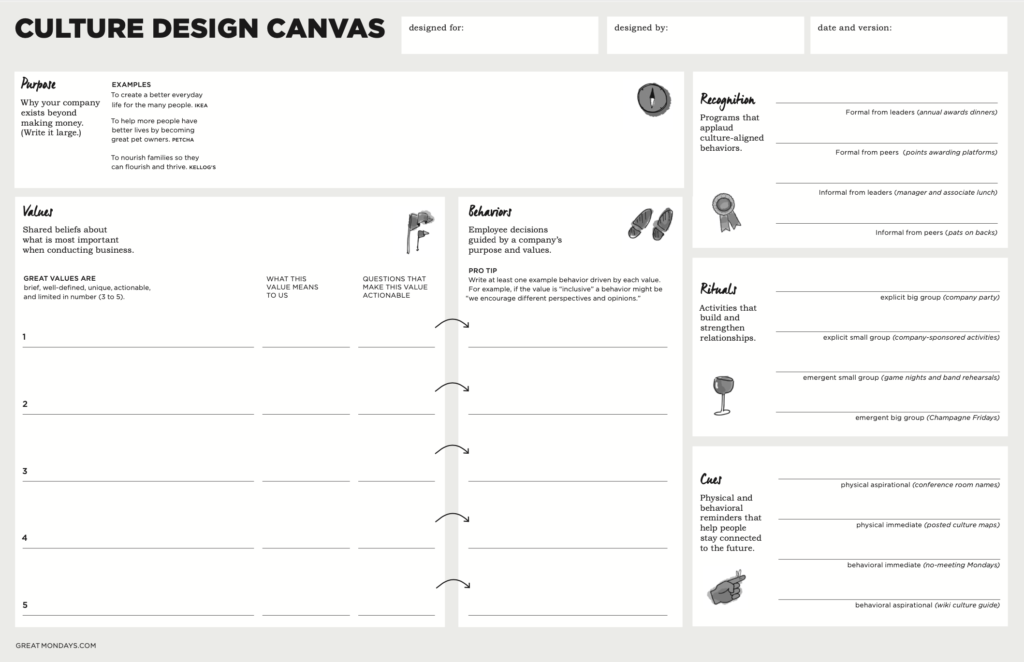We’ve heard people wondering, “Why are we talking about culture if everyone’s remote?” If you’re in the same boat, we hear you: it’s a great question, and it’s never been more important to address the role of culture for remote teams. Especially now that so many of us are working from home — in many cases, for the first time, and in a particularly unplanned way thanks to COVID-19 — it’s important to take a closer look at culture, and intentionally plan how to make it stronger and more meaningful for employees.
Below, we’ve recapped our webinar with Josh Levine, Bobby Melloy, and Donut’s own Arielle Shipper, where we dove into what Josh has defined as the Culture Canvas: a tool to systematically examine the 6 drivers of culture, and intentionally set up the building blocks in your organization. In this blog post, we’ll discuss the components of the Culture Canvas: what they are, why they matter, and some examples and insights from Josh, Bobby, Arielle, and our attendees.
Especially now during the coronavirus pandemic, it’s important to connect the work we do to the reason why we do it, and Josh summed up the business case and people case for stronger culture nicely. “There’s a benefit [of defining culture] to the business, and the customer, and also the employee — helping people be better through the work that they do.” Thanks again to everyone who joined and shared their experiences with us, — especially the remote culture building activities (which you can see in the chat on the right side of the presentation in the video recording)!
The Culture Canvas

The Canvas is intentionally designed to put your entire culture strategy on one page. It’s helpful for defining culture and focusing activity, and serves as an ongoing reminder of what you’re trying to do. Here are the elements:

“I have had the realization that, for so many, the unspoken purpose of work is togetherness... this pandemic has shifted my understanding of what work means and why work is.”Attendee Jenny S.
Purpose
Purpose is your north star: it’s the reason why your company exists (beyond making money). Internally, it inspires your employees, and externally, it inspires your community! Purpose is a critical rallying point, which is why it’s worth articulating. For example, Ikea’s purpose is a great distillation of why they do what they do: “To create a better everyday life for the many people”.
As Bobby observed, now is a good moment to revisit purpose: when a company is pivoting and/ or people are losing their jobs, or getting furloughed, employees can feel less connected to the purpose. They may ask questions like: am I not important? Is my work not connected to the purpose after all? Especially when re-hiring folks, it’s important to re-examine your purpose and ensure people feel connected to it.

“I've done an exercise where you start with "what we do" -> "how we do it" -> "how we show up" -> "what are our values" -> "what is our purpose.” By building it from the ground up, you can then reverse it to see if you are behaving in a way that is aligned with your purpose. On your way back, "If this is our purpose, do these values align?" -> "If these are our values, is this how we would show up?"... and so on”Attendee Kenna C.
Values
We love Josh’s way of explaining why values are so important: if your purpose is the peak of the mountain, you need guardrails to make sure you don’t go off the sides on your way up to the top. That’s where your values come in! Values are shared beliefs about what is most important when conducting business; they should be brief, well-defined, future-looking, and limited in number.
When setting out on any values exercise, it’s important to hear from members of the team. One way to do this is to pair people from across your organization to identify what they think your values should be, to inform your selection. This connection and collaboration will generate new ideas from unexpected places. Josh shared a great example of values from a company that had identified an ownership challenge, so they redefined their values to include a value called “acknowledge and own.” Nicknamed “ack and own,” the company redeployed language that employees were already familiar with to highlight that ownership and accountability were essential to achieving goals.
Reminder: you should have no more than 5 values, and Josh and Bobby recommend keeping it in the 3-5 range. This will keep your values focused, memorable, and actionable.

“Culture is like fitness… it’s ongoing.”Attendee Candra C.
Behavior
Just because you put it up on a wall doesn’t mean culture’s going to change; behaviors are how we operationalize, incentivize, and support values. Behavior is made up of the choices that an employee makes, every day. When you think about the companies with the best cultures, it’s because their employees are consistently acting in ways that support the company’s values.
Trader Joe’s is a great example of a company that models values-driven behaviors to build culture, product, and customer experience; the delightful in-store experience and customer loyalty speaks for itself! This comes from hiring great people who believe in the mission and values, and practice behaviors that reinforce the values around customer-centricity and connection. That is culture as a competitive advantage.
When you reinforce behaviors, not outcomes, you can sustain culture over time. It’s critical to factor leadership into the equation, as well, as they need to model behaviors in order for employees to adopt and sustain them. To paraphrase Bobby, values will only last as long as people are achieving them!

“Example: We were working in an organization where we wanted people to take more risks to innovate but failure was so hard to accept despite saying it a gazillion times. So our team put together an event where leaders talked about the times they “f$cked up”. The stories had a huge impact.”Attendee Namrata M.
Recognition
It’s important to think about recognition because that’s how the right — or wrong — behaviors are reinforced. Recognition comprises the programs that applaud values-driven behaviors. In order for recognition to reinforce the right behaviors, it needs to be personal for people so that they are invested in doing them more often.
Rewards are one form of recognition, but there are many types: informal and formal; top-down and bottoms-up. The best way to know what recognition people would find meaningful is to ask them! Rewards should always align with your company’s values and be related back to the behaviors you’re looking to reinforce — make it measurable.

“That’s why I love Donut so much: they are strengthening relationships!”Josh Levine, author of Great Mondays
Rituals
Rituals are activities that build and strengthen relationships, and in Josh’s words, “relationships are the synapses of culture.” You need to incorporate rituals because culture can become siloed and brittle as companies scale. When the micro-cultures start to form, there are barriers between people and relationship formation, so you have to create intentional ways to reinforce your larger culture.
Whatever your rituals are, they should reinforce the bonds between employees, and even create new ones! Those connections are what tie employees together and are the foundation of your culture.

“Our LGBT+ ERG is creating a Zoom background with logos from our company LGBT+ workplace awards we've earned through the years. We're going to use them to make virtual pride floats, too!”Attendee Kel H.
Cues
You want to remind employees of the purpose you’re aiming for, and the values that will get you there, so you need to remind them of the behaviors they should be modeling. Cues are the physical and behavioral reminders that help people stay connected, and reminded of what you’re trying to achieve.
Why are cues important? It’s most common to see the mission statement on the wall as a cue, but it can go so much deeper, and attendee Jenny S. thoughtfully predicted that digital work will change this, anyway!
Do you have any other ideas or examples about building culture, especially remotely? We’d love to hear them!